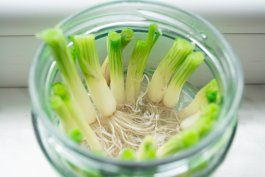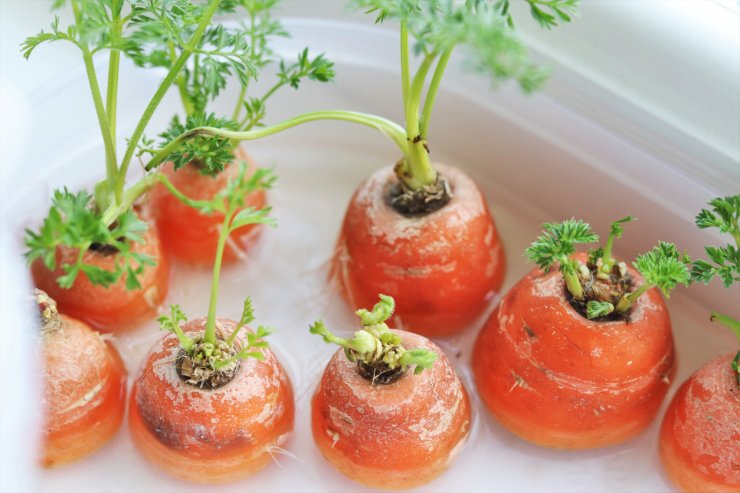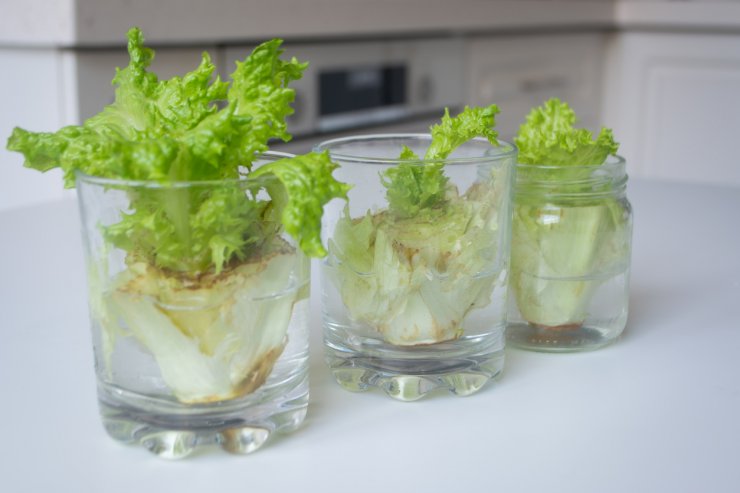
It seems like a myth that you can just chop the head or behind of a vegetable and it’ll just start producing, but it’s actually true. And depending on how much space you want to devote to this effort, you could grow a decent bounty of greens for soups and stocks with your veggie scraps. It’s not very fast, but it’s a lot of fun to do and kids get a kick out of it. Plus, if you’re regrowing green onions, you’ll have garnish for meals indefinitely.
This is a simple exercise in hydroponics, and the science of it is pretty simple: you give a plant water, and it will find a way to grow—no soil needed! In fact, if you grow carrot greens, eventually the carrot tops will produce flowers and bloom.
There are lots of fancy ways people have come up with to grow greens from scraps, but I personally think it’s been made a bit too complicated. When I was learning to grow carrot greens, for example, there were ways to do it on top of marbles and by holding the carrots up with toothpicks, even ways to use newspaper. I’ve tried them all with exactly the same result: carrot greens.
The easiest way? Stick the carrot heads in a shallow bowl or plate of water, and replace the water every few days. No fancy stuff needed.
But that would make for an entirely short story, so let me share with you some more tips for growing greens in water.

How to start regrowing green onions and other vegetables from scraps
Regrowing green onions is actually the most simple of all the vegetables. Not only do they start re-growing within 24 hours, but there are only a few things you need to know:
- Cut the greens about 1-2″ from the roots. Any shorter and they won’t stand up easily in a jar, and any taller, they will create long dry papery stalks as they grow that will take up the whole jar and make the water slimy. They will create this outer shell eventually anyway, but it will take longer with shorter cuts to start.
- Only give enough water to cover the roots and bottom of the green onions. If you give more, they may rot the stalk, which you don’t want. Replace the water every few days.
- Let the onions grow long the first time. The onions will begin to soften and grow a lighter green at each regrowth, so to get the most out of your batch, let them grow about 9″ before beginning to trim, and only trim as much as you need. They will grow back indefinitely, they will just lessen in quality over time.

Green onions are the fastest plant to re-grow and you’ll be able to reap the benefits in about a week, but other veggies like carrots and celery take a bit longer to get anything worth harvesting—we’re talking 3 weeks or more, though the good news is that they follow similar guidelines:
1. Cut at a slight angle. When preparing heads of carrots and butts of celery for water, I like to slice at a slight angle just like I do my Christmas tree so that the bottom isn’t so flat that it doesn’t absorb water. But that’s perhaps more superstition than necessity. With carrots, you don’t have to worry as much because as you’ll find out, roots start growing right out of the sides into the water. It doesn’t hurt, though.
2. Give any rough parts a shave. If you’re getting your veggies from a grocery store and not fresh out of a garden, your veggies may have very well been chilling for a month before getting to you. For example, if you get a head of celery, the bottom will be pretty dried out, so I like to give it a quick shave on the bottom so it has a better chance of absorbing water.
3. Offer just enough water to grow, and change frequently. If you submerge your plants in water, they will rot. Give them just enough to drink without drying out, and refresh the water every couple days. As they grow, they may need water more frequently.
4. Throw away anything that is molding or rotting. For example, if you have a batch of 10 carrot heads and one begins to mold, throw out the spoiled carrot, replace the water. If the outside of your celery is beginning to get brown and mushy because your water was too high, remove those outer stalks. I like to start with a bigger diameter of celery (aka the whole end) so that I have room to pull stalks off if this happens, rather than starting with the smaller inner core of the celery where there’s no room for error.

You can use this method for other root vegetables like beets as well. Carrot greens make a great pesto and beet greens are delightful with just a little olive oil, salt, and pepper. Like celery, you can also grow leeks and lettuce using the same method.
If you’ve grown veggies like these, I’d love to hear how you’ve done it and what you use the greens for. Let me know in the comments.


 Previous
Previous


Love this idea! Thank you!!
I just started helping out at a STEA2M 9Science, Technology, Arts, Agriculture, and Math) facility for elementary kids a couple of months ago. I am going to do this with them! Great activity!
Do regrown carrots produce usable carrot roots or just the tops?
I use the green onion growth the same as chives.
I’m gonna try this